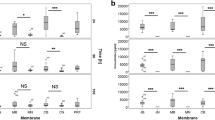Abstract
Previous studies have reported that sulfated β-cyclodextrin, a naturally occurring cycloamylose built up from six to eight glucopyranose units, when administered alone promotes angiogenesis, but administered with an angiostatic steroid inhibits angiogenesis in the cick embryo bioassay. In our experiments sulfated β-cyclodextrin has been shown to posses many properties unrelated to its classical functions in the promotion and inhibition of angiogenesis that were not previously described. We studied the angiogenic and angiostatic properties of β-cyclodextrin in a subcutaneosus plastic sponge model in mice. We realized two set of experiments. In each set mice were randomized into five groups (n= 5 mice). The first group was treated with sulfated β-cyclodextrin (200 ng), the second group was treated with sulfated β-cyclodextrin (2000 ng), the third group received unsubstituted β-cyclodextrin (2000 ng), the fourth group was treated with sulfated β-cyclodextrin (20 000 ng) and the last group was used as a control group. In all groups compounds were administered intraperitonally 4 days after subcutaneous implantation of a sterile polyvinyl sponge on day 0, controls were not treated. Cyclodextrin administered alone at low drug concentration (200 ng) promoted angiogenesis and increased the development of venules in the sponge matrix. However, cyclodextrin administered at high drug concentration (2000 and 20 000 ng) reduced the vessel index in the sponge and areas of microhemorraghes were observed. From our results we propose that β-cyclodextrin contains both a promoter and an inhibitor of angiogenesis and that the activation of both is drug concentration dependent.
Similar content being viewed by others
References
Bender ML, Kaniyama M: Cyclodextrin Chemistry. Springer Verlag, Berlin, 1978.
Bergeron RJ: In Inclusion Compounds, Arwood JL, Davies JED, MacNicol DD (eds); Academic Press, New York, Vol. 3, pp 391–443, 1984.
Bishop DK, Jutila MA, Sedmak DD, et al: Lymphocyte entry, NTO Inflammatory Tissuesin vivo. Qualitative Differences of High Endothelial venule-like vessels in Sponge Matrix Allografts vs Isografts. J Immunol 142:4219–4224, 1989.
Boyle EA, Mangan FR: The effect of a novel, non-steroidal anti-inflammatory compound, nabumetol (BRL14777), on cellular infiltration into 24-hour polyvinyl sponge implants in the rat, compared with some steroidal and non-steroidal antiinflammatory drugs. J Pharm Pharmacol. 34:570–575, 1982
Carmeliet P, Rakesh JK: Angiogenesis in cancer and other diseases. Nature 407:249–256, 2000.
Dierendonck JH: A new method to detect apoptosis in poraffin sections: in situ end-labelling of fragmented DNA. J Histochem Cytochem 41, 7, 1993.
Folkman J, Langer R, Linhardt RJ, et al: Angiogenesis inhibition and tumor regression caused by heparin or a heparin fragment in the presence of cortisone. Science 221:719–725, 1983.
Folkman J, et al: Control of Angiogenesis with Synthetic Heparin Substitutes. Science 243:1490–1493, 1989.
Frank SG, Kavaliunas DR: Investigation of the beta-cyclodextrin hydrocortisone inclusion compound. J Pharm Sci 72:1215, 1983.
Freeman PC, Mangan FR, Wathius DK: Some effects of hydrocortisone on the early development of the rat cotton pellet granuloma. Biochem Pharmacol 29:372–373, 1979.
Gavrieli Y, et al: Identification of programmed cell death in situ via specific labeling of nuclear DNA fragmentation. J Cell Biol 119:493–501, 1992.
Griffoen AW, Molena G: Angiogenesis: Potentials for Pharmacologic Intervention in the Treatment of Cancer, Cardiovascular Diseases, and Chronic Inflammation. Pharmacological Rev 52: 238–268, 2000.
Guerrero A, et al: Actividad antineoplαsica ejercida por quinacrina oral sobre tumors malignos transplantables en ratón. Revista Chilena de Cancerología 2:119–122, 1992.
Koch AE, Halloran MM, Haskell C: Angiogenesis mediated by soluble forms of E-selectin and vascular cell adhesion molecule-1. Nature 376:517–519, 1995.
Lubec G: Interactions of N-CAM with heparin-like molecule. Nature 323: 743–474, 1986.
Nangia-Makker P, Hanjo Y, et al: Galectin-3 Induces Endothelial Cell Morphogenesis and angiogenesis. Am J Pathol 156:899–909, 2000.
Nguyen M, Stubel NA, Bischoff J: A role for sialyl Lewis-X/A glycoconjugates in capillary morphogenesis. Nature 365:267–269, 1996.
O’Reilly MS, et al: Angiostatin: A circulating endothelial cell inhibitor that suppresses angiogenesis and tumor growth. In: Cold Spring Harbor Symposia Quant Biol 59:471–482, 1994.
Wijsman JA, Janker RR, Keijzer R, et al: A new method to detect apoptosis in paraffin sections: In situ endlabelling of fragmented DNA. J Histochem and Cytochem 41:7–12, 1993.
Author information
Authors and Affiliations
Corresponding author
Rights and permissions
About this article
Cite this article
Strauss, L., Fuenzalida, M., Illanes, J. et al. Effect of sulfated β-cyclodextrin, a water soluble cycloamylose, on the promotion and/or inhibition of angiogenesis. Pathol. Oncol. Res. 8, 47–53 (2002). https://doi.org/10.1007/BF03033701
Received:
Accepted:
Issue Date:
DOI: https://doi.org/10.1007/BF03033701




